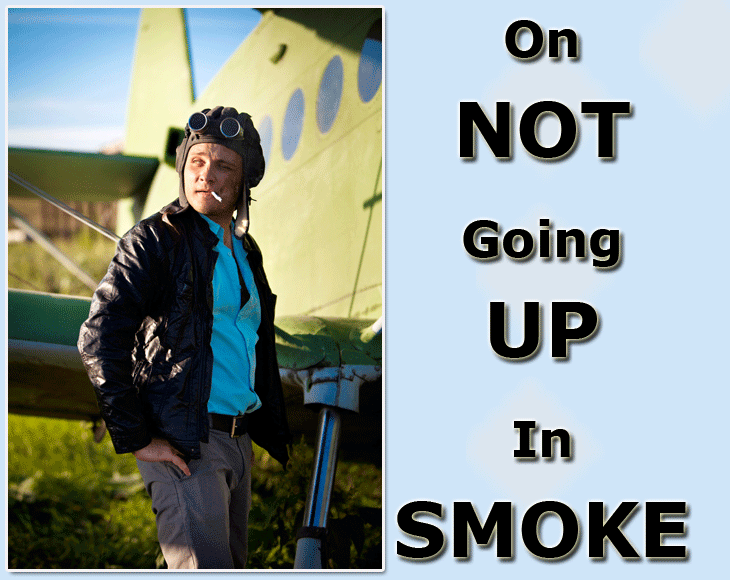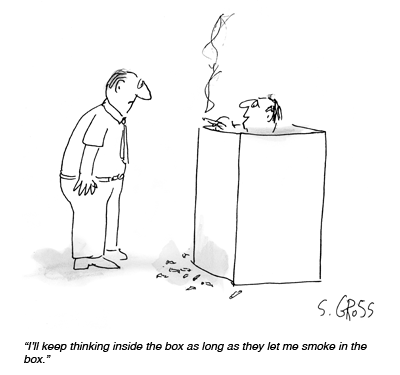
The good, the
bad and the politically incorrect
For FT readers below
the age of 40, this may sound utterly alien: There was a time when smoking
was permitted almost everywhere. That time is gone for good, and older
movies are often re-cut to erase smoking scenes.
But sometimes that just isn’t feasible:
Humphrey Bogart in Casablanca, Cary Grant in North by Northwest,
or Marlene Dietrich in The Blue Angel would be unthinkable without
the actors celebrating their smokes. Advertisements for cigarettes were
everywhere, and it was not unusual for such advertisements to state that
a particular brand was recommended by doctors or dentists.
The late 1970s saw non-smoking sections coming
to aircraft, and while the anti-tobacco movement gained momentum and advertising
for tobacco products was increasingly frowned upon during the 1980s and
early 1990s, legal measures were taken by regulators to outright ban smoking
aboard commercial passenger aircraft worldwide.
Spearheaded by consumer advocate Ralph Nader
(who is best remembered for his book about the Chevrolet Corvair, Unsafe
at Any Speed), calls for a total smoking ban saw United Airlines become
the first airline ever to introduce a non-smoking section in 1971.
However, any explicit regulation was vociferously
opposed by both the manufacturers of tobacco products and the airlines
themselves, not to mention the majority of passengers who at that time
did smoke.
The U.S. CAB (Civil Aeronautics Board, predecessor
to what in 1957 and 1958 became the FAA and NTSB) banned smoking aboard
commercial passenger airliners in 1984 just to unban it in the same year
over concerns of lacking legal foundations for such ban. The CAB chairman
Dan McKinnon commented upon announcing the retraction of the CAB’s
ban: "Philosophically, I think nonsmokers have rights, but it comes
into market conflict with practicalities and the realities of life."
With increased campaigning from the side of the
anti-smoking movement and increased awareness about smoking and second-hand-smoke-related
health concerns, the U.S. Congress decided on a gradual ban on inflight
smoking, starting with domestic flights of two hours or less in April
1988, extended to domestic flights of six hours or less in February 1990,
and expanded to all domestic and international flights in 2000.
It is noteworthy that the ban applied only to
commercial passengers and not to the flight deck: pilots were allowed
to continue smoking due to concerns about potential flight safety issues
caused by nicotine withdrawal.
Soon, other regulatory authorities followed U.S.
regulations and banned smoking aboard commercial passenger airliners operated
to, from, or through their territory.
The airlines (including their interest group
IATA) had in the meantime reconsidered their approach since by the early
1990s, a majority of passengers (albeit a slight one) favored a smoke-free
environment. It was, however, not all about the passenger’s health
and well-being as airlines’ updated policies would have customers
believe: The four main reasons to ban smoking on the airline side were
as follows. First, there was regulatory pressure. Second, there were concerns
about possible lawsuits from passengers exposed to second-hand smoke following
the death of Dr. Abid Hanson on January 4th, 1998. Hanson, who “had
a history of recurrent anaphylactic reactions,” was traveling on
Olympic Airways from Cairo, Egypt, to New York City via Athens, Greece.
Allegedly, he died following exposure to secondhand smoke. A lawsuit filed
by Dr. Hanson’s family against OA awarded compensation and punitive
damages, which were not only upheld by the Court of Appeals but, ultimately,
the Supreme Court awarded the plaintiffs U.S.$1.4 million in compensatory
damages. Third came the simple insight that aircraft interiors tended
to age quickly when exposed to a smoking environment, and fourth the rising
cost of aircraft fuel promised considerable savings from non-smoking flights.
While the latter may come as a surprise to the
average passenger, the technical issue behind it is quite straightforward:
When smoking was still allowed, the air condition systems aboard the aircraft
were running at about two thirds of their capacity in order to exchange
the cabin air and filter out smoke. On non-smoking flights, air condition
systems run at less than a third of their nominal capacity, ironically
promoting the spreading of germs and viruses by means of the drastically
reduced exchange of the cabin air.
The advent of non-smoking flights and the diminished
(and sometimes entirely eliminated smoking facilities at airports) presented
a new problem for the airlines: An increased number of “unruly”
and “disruptive” passengers starved of nicotine as well as
smoke detectors triggered by smoking in lavatories. Smoking aboard a non-smoking
flight carries stiff penalties starting at U.S.$2,000 (U.S.$5,000 in the
U.S.) and possible detaining and arrest upon landing-or worse, the Captain
could also land the plane at an alternate airport, burdening the non-compliant
passenger with the costs of such a diversion.
Air France in the early 2000s tried to balance
the interests of non-smokers against those of smokers by providing “smoking
bars”—small, specifically vented enclosures where smokers
could indulge—on some of their widebodied longhaul aircraft. Since
the technical solution was not perfect and added weight to the aircraft,
these smoking bars were eventually removed in 2003, although these flights
were said to have a significant lower number of “unruly” passengers
than those that were entirely non-smoking.
A number of attempts were made to cater to the
need of smokers in other ways:
Smokers Express Airlines was a Florida-based
upstart that proposed smoking-only flights domestically within the U.S.
Founded in 1993, Smokers Express Airlines never managed to receive sufficient
funding to get off the ground. As applicable FAA regulations at that time
already forbade smoking on domestic flights within the U.S., potential
flyers were required to join and pay an annual fee of U.S.$25 and be 21
or older.
 The latest attempt was made in 2006 when German businessman Alexander
Schoppmann founded Smintair (short for Smoker International Airways).
Schoppmann planned to operate two 747-400 in a 138-seat all-business configuration
on the Dusseldorf-–Osaka and Dusseldorf–Tokyo route. Although
one of the aircraft had already been leased and traffic rights had been
acquired, the inaugural flight was postponed thrice before the airline-that-could-have-been
died a silent death—allegedly the required funding was, once again,
insufficient, although Smintair had already hired the majority of the
essential post holders required to get an Air Operator Certificate. The
job advertisements contained a clear mission statement: “if you
are allergic against tobacco smoke or if you are a militant non-smoker,
you are expressly encouraged to refrain from applying for this job.”
When asked about the financial feasibility of all-business flights between
Germany and Japan, Schoppmann outlined that Japanese salarymen more often
than not smoke and are willing to pay for a premium smoking ticket. As
a side effect, the 138 seat configuration would make for a high cargo
payload on a sector where cargo yields (at that time) were some of the
highest industrywide.
The latest attempt was made in 2006 when German businessman Alexander
Schoppmann founded Smintair (short for Smoker International Airways).
Schoppmann planned to operate two 747-400 in a 138-seat all-business configuration
on the Dusseldorf-–Osaka and Dusseldorf–Tokyo route. Although
one of the aircraft had already been leased and traffic rights had been
acquired, the inaugural flight was postponed thrice before the airline-that-could-have-been
died a silent death—allegedly the required funding was, once again,
insufficient, although Smintair had already hired the majority of the
essential post holders required to get an Air Operator Certificate. The
job advertisements contained a clear mission statement: “if you
are allergic against tobacco smoke or if you are a militant non-smoker,
you are expressly encouraged to refrain from applying for this job.”
When asked about the financial feasibility of all-business flights between
Germany and Japan, Schoppmann outlined that Japanese salarymen more often
than not smoke and are willing to pay for a premium smoking ticket. As
a side effect, the 138 seat configuration would make for a high cargo
payload on a sector where cargo yields (at that time) were some of the
highest industrywide.
Likely, in times where smoking is increasingly
frowned upon and seen as socially unacceptable behavior, no renewed attempt
to get a smoking airline off the ground will be made—although the
issue is far from closed: There are increasing reports of cockpit crews
of both passenger and cargo flights still smoking, and pilots of Spanish
flag carrier Iberia resorted to union action following a ban on shorthaul
flights in the 1990s by Spanish regulators.
Most recently, e-cigarettes have become a big
issue. Since electronic cigarettes give off just vapor but no smoke, these
are not covered by the present bans of smoking aboard aircraft. IATA however
has published guidance vociferously opposing the use of such e-cigarettes
during the flight, saying that this could mislead other passengers in
a way that the consumption of real cigarettes was permitted, as well as
other “safety concerns.” The fact that a passenger deprived
of nicotine may be a much bigger safety risk has apparently not occurred
to them.
A very real threat stemming from such e-cigarettes
however has recently been addressed in a FAA SAFO (Safety Alert For Operators):
On numerous occasions, the Lithium batteries in these e-cigarettes seem
to have malfunctioned or the heating elements not turned off by their
users, thus causing baggage fires. In its SAFO, the FAA urges operators
to permit carriage of e-cigarettes within carry-on baggage only so that
“if an incident does occur, it can be immediately identified and
mitigated.”
And in case you ever wondered why, more than
20 years after banning smoking on aircraft, the lavatories—even
on the newest aircraft—feature ashtrays: These are actually mandated
by applicable FAA and EASA airworthiness regulations.
14 CFR 25.853 requires ashtrays in lavatories
for the simple reason that people will smoke, whether permitted or not,
and in such cases an ashtray present is a much safer means of disposal
than the wastebin. As a matter of fact, ashtrays are still on the airline’s
MEL (Minimum Equipment List) for that pragmatic reason.
Jens

|





